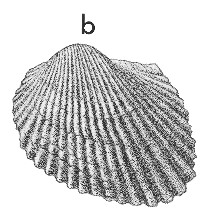
Revised descriptions of New Zealand Cenozoic Mollusca from Beu and Maxwell (1990)

 | Revised descriptions of New Zealand Cenozoic Mollusca from Beu and Maxwell (1990) | 
|
  (Pl. 44b): GS11475, R11/f7743, dredged in Rangitoto Channel, Auckland Harbour, Haweran (oxygen isotope stage 5e?), a small left valve (large valves are longer and narrower) |
  (Pl. 44e): GS11475, R11/f7743, dredged in Rangitoto Channel, Auckland Harbour, Haweran (oxygen isotope stage 5e?), a small left valve (large valves are longer and narrower) |
Beu & Maxwell (1990): Chapter 16; p. 334; pl. 44 b,e.
Synonymy: Arca trapezia Deshayes 1839, p. 358; Arca lobata Reeve 1844 (in 1843-1844), pl. 3, fig. 19; Diluvarca trapezia
Classification: Arcidae: Anadarinae
Description: Moderately large for genus (to at least 80 mm long), thick and solid, strongly inflated, coarsely ribbed. Hinge line long and straight, with umbo protruding strongly above it at anterior 0.2-0.3 of shell length; anterior margin evenly rounded; posterior margin sloping backward; dorsal and ventral margins nearly straight but diverging posteriorly, producing an oblique rhomboidal, postero-ventral extension of shell shape. Exterior sculptured with 25-27 prominent, wide, widely spaced, radial costae of almost square section, smooth except for weak commarginal growth ridges. Interior of ventral margin coarsely crenulated by radial costae. Hinge a long row of similar teeth; short, straight, vertical ridges over central area but shallowly V-shaped at each end. Wide, shallowly triangular ligamental area between umbo and hinge grows downwards as shell grows, obliterating central hinge teeth of old shells; bearing few, widely spaced, shallow ligamental grooves, shallowly V-shaped in young shells but straight in older ones, and obliterated by many shallow vertical grooves in old individuals. Interior with an obvious, simple pallial line; coarsely striate inside the pallial line except for small, circular, anterior adductor scar and markedly larger, circular, posterior one.
Comparison: Anadara trapezia is the sole Anadara species we are aware of in New Zealand, and is easily recognised by its very large size for a New Zealand arcid, its trapezoidal shape, and its prominent radial costae.
Distribution: Castlecliffian-late Haweran in New Zealand (living in south-eastern Australia); Recent, Australia (types of Arca trapezia and A. lobata). Extinct in New Zealand (since the previous interglacial, oxygen isotope stage 5e, 125 000 years ago) but the "Sydney mud cockle" of New South Wales today, living abundantly, shallowly buried in sand or mud "eel-grass" (Zostera) flats in estuaries and enclosed bays, with salinity a little lower than oceanic; dead, evidently recently (geologically) extinct colonies occur in Port Phillip, Victoria, and in South Australia. New Zealand localities range from late Castlecliffian (oxygen isotope stage 11; Wanganui basin) to late Haweran (oxygen isotope stage 5e; youngest high terrace on Mahia Peninsula), so this provides one of few molluscan biostratigraphic guides over this young period. Murray-Wallace et al. (2000) recorded its range and significance in Australia, and Beu (2004, pp. 134-139) listed localities in New Zealand in detail. Superabundant in the high terrace cover on Kaiti Hill, Gisborne (oxygen isotope stage 5e); common in a drillhole at Clive, Hawke's Bay (oxygen isotope stage 7); common in dredgings from Rangitoto Channel, Auckland (oxygen isotope stage 5e), in drillholes at Marsden Pt, Whangarei (beyond the range of conventional C14; Fleming and Powell 1974), in a fossil mud-flat community at at least two localities in Hokianga Harbour (oxygen isotope stage 5e), and still washing ashore (very abraded) on Spirits Bay and other northern beaches, Northland.
Cite this publication as: "A.G. Beu and J.I. Raine (2009). Revised
descriptions of New Zealand Cenozoic Mollusca from Beu and Maxwell (1990). GNS
Science miscellaneous series no. 27."
© GNS Science, 2009
ISBN
978-0-478-19705-1
ISSN 1177-2441
(Included with a PDF facsimile file
copy of New Zealand Geological Survey Paleontological Bulletin 58 in CD version
from: Publications Officer, GNS Science, P.O. Box 30368 Lower Hutt, New
Zealand)